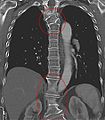- Congenital vertebral anomaly
-
Congenital vertebral anomalies are a collection of malformations of the spine in animals. Most are not clinically significant, but they can cause compression of the spinal cord by deforming the vertebral canal or causing instability. This condition occurs in the womb. Congenital vertebral anomalies include alterations of the shape and number of vertebrae.
Contents
Hemivertebrae
Among the congenital vertebral anomalies, hemivertebrae are the most likely to cause neurologic problems.[1] They are wedge shaped vertebrae, and therefore can cause an angle in the spine (such as kyphosis, scoliosis, and lordosis). The most common location is the midthoracic vertebrae, especially the eighth (T8).[2] Neurologic signs result from severe angulation of the spine, narrowing of the spinal canal, instability of the spine, and luxation or fracture of the vertebrae. Signs include rear limb weakness or paralysis, urine or fecal incontinence, and spinal pain.[1] Most cases of hemivertebrae have no or mild symptoms, so treatment is usually conservative. Severe cases may respond to surgical spinal cord decompression and vertebral stabilization.[2]
The probable cause of hemivertebrae is a lack of blood supply causing part of the vertebrae to not form. Hemivertebrae in dogs are most common in the tail, resulting in a screw shape, but can also occur in the thoracic vertebrae. Affected dog breeds include Bulldogs and French Bulldogs, Pugs, and Boston Terriers. It is inherited in Yorkshire Terriers[3] and German Shorthaired Pointers.[4] The condition can cause death in very young Bulldog puppies.[3]
Block vertebrae
Block vertebrae occur when there is improper segmentation of the vertebrae, leading to parts of or the entire vertebrae being fused. It can lead to an angle in the spine, but there are usually no symptoms. The sacrum is a normal block vertebrae.
Fossil record
Main article: PaleopathologyEvidence for block vertebrae found in the fossil record is studied by paleopathologists, specialists in ancient disease and injury. A block vertebrae has been documented in T. rex. This suggests that the basic development pattern of vertebrae goes at least as far back as the most recent common ancestor of archosaurs and mammals. The tyrannosaur's block vertebra was probably caused by a "failure of the resegmentation of the sclerotomes."[5]
Gallery
Butterfly vertebrae
Butterfly vertebrae have a cleft through the body of the vertebrae and a funnel shape at the ends. This gives the appearance of a butterfly on an x-ray. It is caused by persistence of the notochord (which usually only remains as the center of the intervertebral disc) during vertebrae formation. There are usually no symptoms. Butterfly vertebrae occur most often in Bulldogs, Pugs, and Boston Terriers.[3]
Transitional vertebrae
Transitional vertebrae have the characteristics of two types of vertebra. The condition usually involves the vertebral arch or transverse processes. It occurs at the cervicothoracic, thoracolumbar, or lumbosacral junction. For instance, the transverse process of the last cervical vertebra may resemble a rib. A transitional vertebra at the lumbosacral junction can cause arthritis, disk changes, or spinal cord compression. One study found that male German Shepherd Dogs with a lumbosacral transitional vertebra are at greater risk for cauda equina syndrome, which can cause rear limb weakness and incontinence.[6]
Spina bifida
Spina bifida is characterized by a midline cleft in the vertebral arch. It usually causes no symptoms in dogs. It is seen most commonly in Bulldogs and Manx cats.[1] In Manx it accompanies a condition known as sacrocaudal dysgenesis that gives these cats their characteristic tailless or stumpy tail appearance. It is inherited in Manx as an autosomal dominant trait.[4]
References
- ^ a b c Braund, K.G. (2003). "Developmental Disorders". Clinical Neurology in Small Animals: Localization, Diagnosis and Treatment. http://www.ivis.org/special_books/Braund/braund16/chapter_frm.asp?LA=1#Vertebral_Anomalies. Retrieved 2007-02-04.
- ^ a b Jeffery N, Smith P, Talbot C (2007). "Imaging findings and surgical treatment of hemivertebrae in three dogs". J Am Vet Med Assoc 230 (4): 532–6. doi:10.2460/javma.230.4.532. PMID 17302550.
- ^ a b c Ettinger, Stephen J.;Feldman, Edward C. (1995). Textbook of Veterinary Internal Medicine (4th ed.). W.B. Saunders Company. ISBN 0-7216-6795-3.
- ^ a b "Congenital and Inherited Anomalies of the Nervous System: Small Animals". The Merck Veterinary Manual. 2006. http://www.merckvetmanual.com/mvm/index.jsp?cfile=htm/bc/100416.htm. Retrieved 2007-02-04.
- ^ Molnar, R. E., 2001, Theropod paleopathology: a literature survey: In: Mesozoic Vertebrate Life, edited by Tanke, D. H., and Carpenter, K., Indiana University Press, p. 337-363.
- ^ Flückiger M, Damur-Djuric N, Hässig M, Morgan J, Steffen F (2006). "A lumbosacral transitional vertebra in the dog predisposes to cauda equina syndrome". Vet Radiol Ultrasound 47 (1): 39–44. doi:10.1111/j.1740-8261.2005.00103.x. PMID 16429983.
Categories:- Dog diseases
Wikimedia Foundation. 2010.




